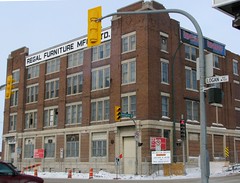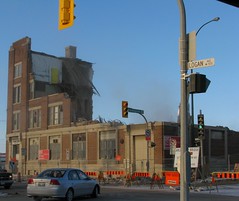One way to do this is to take the information and images out from the bowels of archive collections and get them online so that people can actually see them. Groups in many jurisdictions have made huge strides in recent years digitize their archives but in that same period what little Manitoba has to offer has atrophied.
What got me thinking about this topic was a barely-newsworthy item from earlier this year.
The Ontario Wind Engine and Pump / Regal Furniture building at 925 Logan Avenue was to be torn down. In a related newspaper article it was pointed out that neither the city nor Heritage Winnipeg knew anything about the history of the building. That was a bit maddening to me considering that these two groups have the mandate and the tools at-hand, (city records, newspaper archives), to find out this sort of thing. For example:
The city's Historic Buildings Committee, (Planning Property and Development): "As the City receives permits for these buildings, the Historical Buildings Committee evaluates and recommends designation of the structure based on their research."Heritage Winnipeg: "To promote and encourage the conservation of historic/heritage structures and sites and attend to those matters which enhance and complement this purpose."
It's hard to evaluate, promote, encourage or recommend anything if you know nothing about the building in question and that brings me back to the state Manitoba's online heritage resources.
There are a number of Manitoba-based sites that at are a treasure trove of information but have barely been touched in recent years to add or update content or to make them easier to search. Here is a list of some of the main archive and heritage websites from Manitoba and a bit of a critique of each from this armchair historian:
Manitoba Archives: The site is set up with the same template as Manitoba Health and any other provincial government department. Almost nothing from their content is viewable online. Back in 2008 there was a bright spot with RearView but years later there still only six entries on the site.
If you take a look at other provincial archives such as B.C. Archives or the Archives of Ontario they are miles ahead. Ontario gets an added bonus for their archives building being open on Saturdays so that people with day jobs can access it.
Closer to home, the Saskatchewan Archives Board is a funding partner on great online resources like the Encyclopedia of Saskatchewan (based at the of U of Regina) which is easily accessible and searchable.
An added slap is that Manitoba's archives building is open only bankers hours so what they do have available in-person requires you to take time off work.
Virtual Heritage Winnipeg is one of the best places for building information. It's circa 2000 or so and features a really clunky search engine (you have to know in advance if, say, the Leland Hotel is considered a "Commercial Building", part of a "Winnipeg Street" or a "Panorama" or else you have to search all three databases separately). The photos are almost exclusively from the the Manitoba Archives and open in half-postcard size which makes looking at any detail impossible.
Last year, HW launched a Flickr page which seemed like an excellent idea for a non-profit. It's easily accessible, searchable and cheap. Though some pages from booklets have been uploaded along with a lot of grainy newspaper photos, it has not been used anywhere near its potential.
Manitoba Historical Society is the best of the local website but also has limitations.
It was originally set up as a repository for Manitoba History magazine articles (which unfortunately are published there after a two year delay). Magazine articles, of course, get stale, so a 1979 article on River Road in Lockport is just a snapshot at that time and doesn't include any new developments, findings or building designations.
That said, MHS has added interesting features to their site.
They saved TimeLinks. That was probably the best database of historic photos from around the province. A project of River East Collegiate, when the site name expired so did the website. They've added a Q and A forum for Manitoba History Questions and an interactive map of Manitoba Historical sites.
Still, the website is set up primarily as a magazine article database and many of these features get lost in that format.
City Historic Building Database is a great resource but you really have to know what you are looking for in advance and there is no mapping function or ability to search across reports. Also, many of the long articles it seems were done in the late 1980s or early 1990s so don't reflect recent changes or findings.
The shorter 'overview' section should be a 'category killer' for local historic buildings but, again, appears that very little has been added over time.
Another sad thing is that once building has been demolished, it is no longer a part of the heritage buildings database and the report is removed from the site never to be seen again.
University of Manitoba has a great collection but the collections are contained in separate silos making cross-searching difficult. A bright spot is LUNA which gives you the ability to search images from a number of collections, though is a bit awkward to find or use.
Their Tribune Collection made a splash at the turn of the century but appears to have nothing new added to it since then.
The Winnipeg Building Index has, by neglect, become a great heritage site. Never completed, you can see that by the number of missing buildings or those without photos yet added, the original images for most of the entries date back to the late 1980s or early 1990s. As a result City Place is still Eaton Place and the Northwest Company building on Main Street is still Hudson Bay House.
City of Winnipeg Archives went from zero to sixty a few years back with Pathways but little, if anything, has been added to the site since then leaving 99% of what the city has in boxes.
Western Canada Pictorial Index has a great collection and good search engine but you can't actually see any of the images online ! It's a text-only description of what the photo looks like.
McKee Archives (Brandon University) is an interesting collection of photos from Brandon and area. Unfortunately, you have to know that the site is there or you'll never find it online.
So, where is the new online information on Manitoba coming from ? Surprisingly, Alberta. Places like Glenbow (Alberta) and Peel's (University of Alberta) have become excellent sources on Winnipeg and Manitoba history.
Locally, it has been left to individuals to upload content. Flickr's Manitoba Historical Maps, winterbos, buflyer have brought to the web a great deal of never before seen information. (Buflyer now has what is likely the largest on-line collection of Foote photos.) Blogs like this one, The Common, St. Vincent Memories (based in Minnesota) continue to add new Manitoba-related.
This citizen involvement is a good thing but has drawbacks. While most try to provide complete source information, this isn't always the case. Also, there is the 'hit by a bus' factor as all of this information can be gone with the click of a button or the expiry of an online account.
This happened with TimeLinks. It was a digitization project of some River East Collegiate students in the early 2000s. When the site expired the collection was lost. Sometime later the Manitoba Historical Society rescued it. The images aren't full sized but as far as Manitoba online history goes it's still a great resource that was almost lost.
I realize that it takes a mandate as well as time, manpower and money to to digitize archives, something most of these groups don't have a lot of. Still, at least one of the main heritage-related groups needs to step up and take the lead on an up-to-date, online heritage resource for Manitoba. (At the very least, they need to start with updating their own online resources).
Again, as just an armchair historian, here are a few suggestions:
1. Make it part of your mandate to get stuff online and update it. I realize that the administration of offices, staff, museums, maintaining collections, holding meeting etc. takes up a lot of time and money, but if you're looking at your five year plan and it doesn't dedicate significant resources to online ventures, you're working in reverse.
Holding most of your collection in storage behind a phalanx of staff there to explain repeatedly how to get them to access it is like analog television. It makes you outdated and, for many, irrelevant as online collections pass you by.
2. New ways of getting information out. Years ago digitization had its pitfalls. The organization / department's website would have to be updated which required layers of bureaucracy to get approval and then the time and money for a techie to insert the new data.
Today, however, there are numerous sites dedicated to online data storage and display. For instance, the archive that must have the largest bureaucracy to deal with, Library and Archives Canada, has bypassed all this. They now have a Flickr album that they are updating their collection to AND a blog that tells researchers in "real people" terms how to find what you are looking for. It's active, regularly update and a great example of what can be done using existing, manly free, online tools.
Digitizing information is not only a good external project but works internally as well. Take some of that staff time used to do physical searches of your collection, or to have to stand at a counter and explain dozens of times a day to the public how to do basic searches, and put that time and money into other things - keeping the archives open later hours or working to digitize more items.
Another added bonus of online archives, if through Flickr, is that people can add relevant information.
I recall one visit to the provincial archives where I stumbled across a couple of Foote photos marked "unknown". They were, actually, photos of the Riverview Hotel in Elmwood that burned down in 1918. I had done research on the building and for the family of one of the people who died in the fire. When I told the staff that I could attribute a name to the image, they were not interested. The information would not get a new index card nor could I note it on the old card. THAT was not part of what they did, they just held the collection. Sadly, the photo got inserted back into the filing cabinets of tens of thousands of photos and nobody will ever know that it exists.
If something like Flickr was used, this information COULD be added in the comments section and someone looking into the hotel, or the street or Elmwood history etc., would be able to discover it.
3. Combine databases. Rather than a number of aged, incomplete databases maintained by small groups, why can't there be a pooled effort ? Take just the existing online photo archives of TimeLinks, the Winnipeg Building Index, Heritage Winnipeg and the Historic Building Committee and you'd have a formidable index.
A pooled database can open the door for more funding partners. Look at some of the larger online archives in Canada and you'll see numerous institution, departments, foundations have partnered on these sites. (I imagine this is how Peel's got started - pooling existing databases then seeking out funding partners.)
3. Combine databases. Rather than a number of aged, incomplete databases maintained by small groups, why can't there be a pooled effort ? Take just the existing online photo archives of TimeLinks, the Winnipeg Building Index, Heritage Winnipeg and the Historic Building Committee and you'd have a formidable index.
A pooled database can open the door for more funding partners. Look at some of the larger online archives in Canada and you'll see numerous institution, departments, foundations have partnered on these sites. (I imagine this is how Peel's got started - pooling existing databases then seeking out funding partners.)
To conclude my rambling this Heritage Day, heritage and archive groups have got to get out of the 1990s and up their game when it comes to digitizing their content.
On-line is where people go for information and research today. As time passes you are losing a generation or two of school kids who could be doing Manitoba history projects simply because you are not present where they are looking. These kids are the future historians (amateur or professional), advocates of heritage preservation and members of heritage groups that are slipping away.
Heritage Reflections:
Part 1. The state of MB's online heritage resources
Part 2. 2011 Heritage Winnipeg Conservation Awards
Part 3. It doesn't have to end this way for Winnipeg's Heritage Buildings
Also see:
New York City puts 870,000 images online



















No comments:
Post a Comment